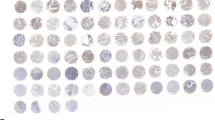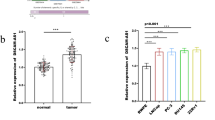Abstract
CD147, also named extracellular matrix metalloproteinase inducer (EMMPRIN), has been shown to be involved in the progression of malignancy by regulating expression of vascular endothelial growth factor (VEGF) and matrix metalloproteinases (MMPs). The goal of this study was to evaluate the role of CD147 in the biology of bladder cancer and to determine its potential as a therapeutic target. CD147 protein expression was detected by immunohistochemistry in 108 bladder cancers using a tissue microarray annotated with patient follow-up. In immunohistochemistry, CD147 protein expression was associated with poor prognosis (P < 0.001), lymph node status (P < 0.001), tumor stage (P = 0.003), histologic grade (P = 0.011). Multivariate analysis showed that CD147 overexpression was an independent prognostic factor (P = 0.019). Infection of T24 bladder cancer cells with an adenovirus that expressed a small interfering RNA (siRNA) against CD147 efficiently inhibited CD147 protein and mRNA expression. This resulted in decreased proliferation, soft agar colony formation, migration, and invasion of T24 cells in vitro. Moreover, downregulation of CD147 reduced secretion of MMP-2 and MMP-9 and expression of VEGF in these cells. Our findings suggest that CD147 overexpression plays an important role in progression of bladder cancer, and CD147 could be a potential target of bladder cancer therapy.





Similar content being viewed by others
Abbreviations
- MMP:
-
Matrix metalloproteinase
- VEGF:
-
Vascular endothelial growth factor
- siRNA:
-
Small interfering RNA
- TCC:
-
Transitional cell carcinoma
- TMA:
-
Tissue microarray
- EMMPRIN(CD147):
-
Extracellular matrix metalloproteinase inducer
- GFP:
-
Green fluorescent protein
- PBS:
-
Phosphate-buffered saline
- HRP:
-
Horseradish peroxidase
References
Jemal A, et al. Cancer statistics, 2009. CA Cancer J Clin. 2009;59:1–25.
Roth BJ, et al. Significant activity of paclitaxel in advanced transitional cell carcinoma of the urothelium: a PhaseII trial of the Eastern Cooperative Oncology Group. J Clin Oncol. 1994;12:2264–70.
Geller NL, Sternberg CN, Penenberg D, Scher H, Yagoda A. Prognostic factors for survival of patients with advanced urothelial tumors treated with methotrexate, vinblastine, doxorubicin, and cisplatin chemotherapy. Cancer. 1991;67:1525–31.
von der Maase H, et al. Long-term survival results of a randomized trial comparing gemcitabine plus cisplatin, with methotrexate, vinblastine, doxorubicin, plus cisplatin in patients with bladder cancer. J Clin Oncol. 2005;23:4602–8.
Biswas C, et al. The human tumor cell-derived collagenase stimulatory factor (renamed EMMPRIN) is a member of the immunoglobulin superfamily. Cancer Res. 1995;55:434–9.
Muramatsu T, Miyauchi T. Basigin (CD147): a multifunctional transmembrane protein involved in reproduction, neural function, inflammation and tumor invasion. Histol Histopathol. 2003;18:981–7.
Chen X, Kanekura T, Kanski T. Expression of basigin in human fetal, infantile and adult skin and in basal cell carcinoma. J Cutan Pathol. 2001;28:184–90.
Gabison EE, Hoang-Xuan T, Mauviel A, Menasi S. EMMPRIN/CD147, an MMP modulator in cancer, development and tissue repair. Biochimie. 2005;87:361–8.
Zhu P, Ding J, Zhou J, Dong WJ, Fan CM. Expression of CD147 on monocytes/macrophages in rheumatoid arthritis: its potential in monocyte accumulation and metalloproteinase production. Arthritis Res Ther. 2005;7:1023–33.
Nabeshima K, et al. EMMPRIN (basigin/CD147): Matrix metalloproteinase modulator and multifunctional cell recognition molecule that plays a critical role in cancer progression. Pathol Int. 2006;56:359–67.
Yan L, Zucker S, Toole BP. Roles of the multifunctional glycoprotein, emmprin (basigin; CD147), in tumor progression. Thromb Haemost. 2005;93:199–204.
Jin JS, et al. Increasing expression of extracellular matrix metalloproteinase inducer in ovary tumors: tissue microarray analysis of immunostaining score with clinicopathological parameters. Int J Gynecol Pathol. 2006;25:140–6.
Sameshima T, et al. Expression of EMMPRIN (CD147), a cell surface inducer of matrix metalloproteinase, in normal human brain and gliomas. Int J Cancer. 2000;88:21–7.
Zheng HC, et al. Upregulated EMMPRIN/CD147 might contribute to growth and angiogenesis of gastric carcinoma: a good marker for local invasion and prognosis. Br J Cancer. 2006;95:1371–8.
Bordador LC, et al. Expression of EMMPRIN by oral squamous cell carcinoma. Int J Cancer. 2000;85:347–52.
Kanekura T, Chen X, Kanznki T. Basigin (CD147) is expressed on melanoma cells and induces tumor cell invasion by stimulating production of matrix metalloproteinase by fibroblast. Int J Cancer. 2002;99:520–8.
Li Y, et al. HAb18G (CD147), a cancer-associated biomarker and its role in cancer detection. Histopathology. 2009;54:677–87.
Zhang Q, et al. Expression of CD147 as a significantly unfavorable prognostic factor in hepatocellular carcinoma. Eur J Cancer Prev. 2007;16:196–202.
Tan H, Ye K, Wang Z, Tang H. CD147 expression as a significant prognostic factor in differentiated thyroid carcinoma. Transl Res. 2008;152:143–9.
Reimers N, et al. Expression of extracellular matrix metalloproteinase inducer on micrometastatic and primary mammary carcinoma cells. Clin Cancer Res. 2004;10:3422–8.
Klein CA, et al. Combined transcriptome and genome analysis of single micrometastatic cells. Nat Biotechnol. 2002;20:387–92.
Marieb EA, et al. Emmprin promotes anchorage-independent growth in human mammary carcinoma cells by stimulating hyaluronan production. Cancer Res. 2004;64:1229–32.
Tang Y, et al. Extracellular matrix metalloproteinase inducer stimulates tumor angiogenesis by elevating vascular endothelial cell growth factor and matrix metalloproteinase. Cancer Res. 2005;65:3193–9.
Muraoka K, et al. Enhanced expression of a tumor-cell-derived collagenase-stimulatory factor in urothelial carcinoma: its usefulness as a tumor marker for bladder cancers. Int J Cancer. 1993;55:19–26.
Als AB, et al. Emmprin and survivin predict response and survival following cisplatin-containing chemotherapy in patients with advanced bladder cancer. Clin Cancer Res. 2007;13:4407–14.
Hidalgo A, et al. A simple method for the construction of a small format tissue array. J Clin Pathol. 2003;56:144–6.
Epstein JI, Amin MB, Reuter VR, Mostofi FK. The World Health Organization/International Society of Urological (transitional cell) neoplasms of the urinary bladder. Bladder Consensus Conference Committee. Am J Surg Pathol. 1998;22:1435–48.
Sobin LH, Fleming ID. TNM classification of malignant tumors, 5th edition (1997). Union International Contre le Cancer and the American Joint Committee on Cancer. Cancer. 1997;80:1803–4.
Masters JR, et al. Tissue culture model of transitional cell carcinoma: characterization of twenty-two human urothelial cell lines. Cancer Res. 1986;46:3630–6.
Chen X, et al. A small interfering CD147-targeting RNA inhibited the proliferation, invasiveness, and metastatic activity of malignant melanoma. Cancer Res. 2006;66:11323–30.
Mohan PM, et al. Adenovirus-mediated delivery of antisense gene to urokinase-type plasminogen activator receptor suppresses glioma invasion and tumor growth. Cancer Res. 1999;59:3369–73.
Li Y, et al. Inhibitory effects of antisense RNA of Hab18G/CD147 on invasion of hepatocellular carcinoma cells in vitro. World J Gastroenterol. 2003;9:2174–7.
Yang H, et al. Effects of cyclophilin A on cell proliferation and gene expression in human vascular smooth muscle cells and endothelial cells. J Surg Res. 2005;123:312–9.
Jin ZG, et al. Cyclophilin A is a secreted growth factor induced by oxidative stress. Circ Res. 2000;87:789–96.
Li M, et al. Cyclophilin A is overexpressed in human pancreatic cancer cells and stimulates cell proliferation through CD147. Cancer. 2006;106:2284–94.
Xu D, Hemler ME. Metabolic activation-related CD147–98 complex. Mol Cell Proteomics. 2005;4:1061–71.
Zucker S, et al. Tumorigenic potential of extracellular matrix metalloproteinase inducer. Am J Pathol. 2001;158:1921–8.
Curran S, Murray GL. Matrix metalloproteinase: molecular aspects of their roles in tumor invasion and metastasis. Eur J Cancer. 2000;36:1621–30.
Dong Z, et al. Matrix metalloproteinase activity and osteoclasts in experimental prostate cancer bone metastasis tissue. Am J Pathol. 2005;166:1173–86.
John A, Tuszynski G. The role of matrix metalloproteinase in tumor angiogenesis and tumor metastasis. Pathol Oncol Res. 2001;7:14–23.
Hicklin DJ, Ellis LM. Role of the vascular endothelial growth factor pathway in tumor growth and angiogenesis. J Clin Oncol. 2005;23:1011–27.
Nakanishi R, et al. Effect of vascular endothelial growth factor and its receptor inhibitor on proliferation and invasion in bladder cancer. Urol Int. 2009;83:98–106.
Sabine R, et al. High incidence of EMMPRIN expression in human tumors. Int J Cancer. 2006;119:1800–10.
Chen X, et al. Ultrastructural localization of basigin in normal human epidermis. Histochem Cell Biol. 2001;115:465–70.
Kuno N, et al. Female sterility in mice lacking the basigin gene, which encodes a transmembrane glycoprotein belonging to the immunoglobulin superfamily. FEBS Lett. 1998;425:191–4.
Sameshima T, et al. Correlation of EMMPRIN expression in vascular endothelial cells with blood-brain-barrier function: a study using magnetic resonance imaging enhanced by Gd-DTPA and immunohistochemistry in brain tumors. Virchows Arch. 2003;442:577–84.
Coste I, et al. Unavailability of CD147 leads to selective erythrocyte trapping in the spleen. Blood. 2001;97:3984–8.
Gabison EE, et al. Differential expression of extracellular matrix metalloproteinase inducer (CD147) in normal and ulcerated corneas: role in epithelio-stromal interactions and matrix metalloproteinase induction. Am J Pathol. 2005;166:209–19.
Acknowledgments
We are very grateful for the sincere help and excellent technical support by the Laboratory of Cell Biology in China Medical University.
Author information
Authors and Affiliations
Corresponding author
Rights and permissions
About this article
Cite this article
Xue, YJ., Lu, Q. & Sun, ZX. CD147 overexpression is a prognostic factor and a potential therapeutic target in bladder cancer. Med Oncol 28, 1363–1372 (2011). https://doi.org/10.1007/s12032-010-9582-4
Received:
Accepted:
Published:
Issue Date:
DOI: https://doi.org/10.1007/s12032-010-9582-4




